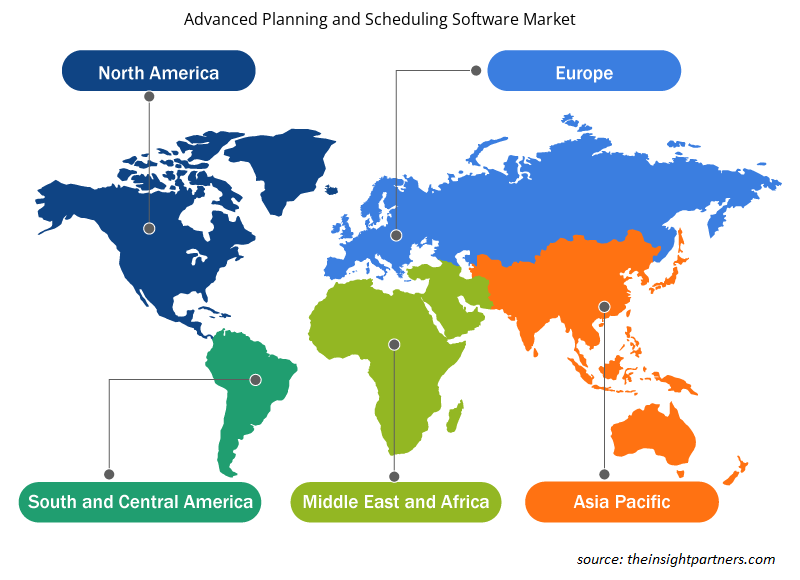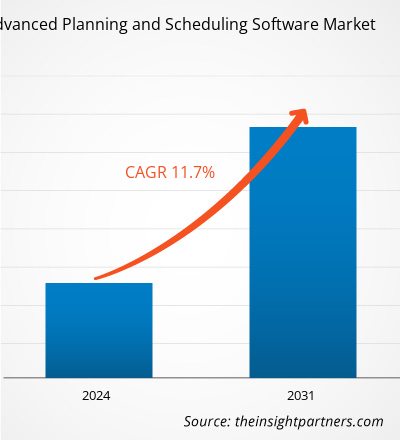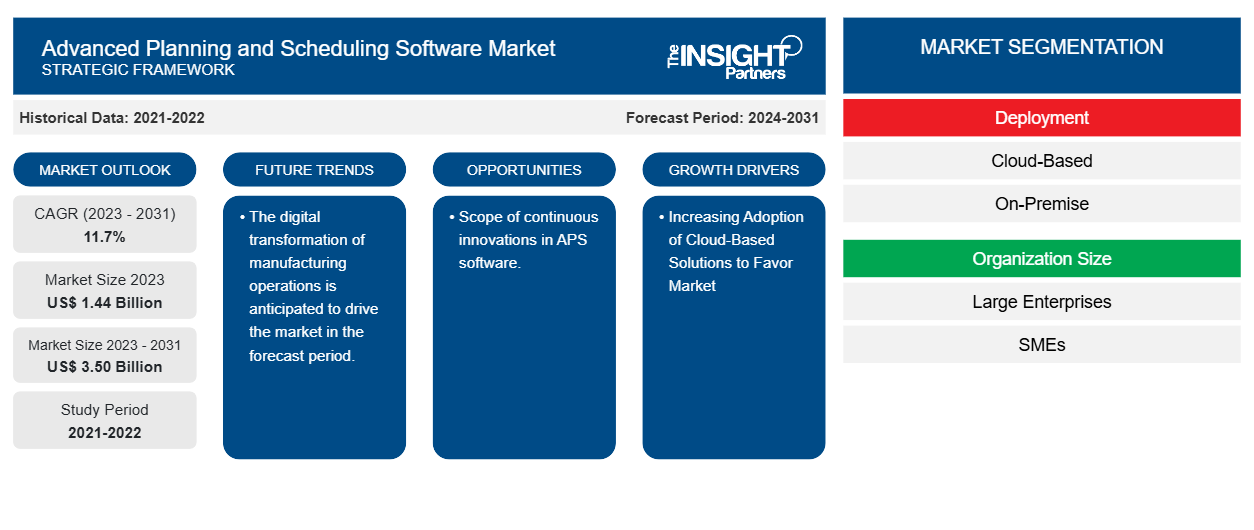Si prevede che il mercato del software di pianificazione e programmazione avanzata raggiungerà i 3,50 miliardi di dollari entro il 2031, passando da 1,44 miliardi di dollari nel 2023. Si prevede che il mercato registrerà un CAGR dell'11,7% nel periodo 2023-2031. La crescente necessità di migliorare il processo di produzione complessivo e l'adozione crescente di soluzioni basate su cloud rimarranno probabilmente tendenze e driver chiave nel mercato.
Analisi di mercato del software di pianificazione e programmazione avanzata
Il mercato dei software di pianificazione e programmazione avanzati sta vivendo una crescita significativa a livello globale. Questa crescita è attribuita alla crescente necessità di migliorare il processo di produzione complessivo e all'adozione crescente di soluzioni basate su cloud. Inoltre, si prevede che la crescente portata di innovazioni continue nel software APS e la trasformazione digitale delle operazioni di produzione offriranno diverse opportunità per il mercato nei prossimi anni.
Panoramica del mercato del software di pianificazione e programmazione avanzata
Advanced planning and scheduling (APS) è una soluzione che aiuta i produttori a controllare la pianificazione della produzione e la programmazione del reparto produttivo. Utilizzando algoritmi avanzati per bilanciare domanda e capacità e produrre programmi di produzione realizzabili, il software di pianificazione e programmazione avanzata si traduce in tempi di consegna più rapidi per soddisfare le richieste dei clienti e risposte più facili e rapide a cambiamenti di produzione imprevisti.
Personalizza questo report in base alle tue esigenze
Riceverai la personalizzazione gratuita di qualsiasi report, comprese parti di questo report, o analisi a livello nazionale, pacchetto dati Excel, oltre a usufruire di grandi offerte e sconti per start-up e università
-
Scopri le principali tendenze di mercato in questo rapporto.Questo campione GRATUITO includerà analisi di dati che spaziano dalle tendenze di mercato alle stime e alle previsioni.
Driver di mercato e opportunità per il software di pianificazione e programmazione avanzata
Crescente adozione di soluzioni basate su cloud per favorire il mercato.
La crescente adozione di soluzioni basate su cloud sta effettivamente guidando la crescita del mercato dei software di pianificazione e programmazione avanzata. Il sistema di pianificazione e programmazione avanzata basato su cloud (CAPS) si basa sulla pianificazione e programmazione dinamica intelligente (IDPS), che è composta da cinque moduli principali, tra cui input, simulazione, pianificazione della capacità (CP), analisi dell'impatto della capacità (CIA) e output. Inoltre, le soluzioni APS basate su cloud consumano bassi investimenti diretti rispetto alle soluzioni on-premise. Ciò aumenta la domanda di organizzazioni di software di pianificazione e programmazione avanzata, comprese le PMI. Pertanto, considerando i parametri di cui sopra, la crescente adozione di soluzioni basate su cloud sta guidando la crescita del mercato dei software di pianificazione e programmazione avanzata.
Ambito delle innovazioni continue nel software APS.
L'ambito delle innovazioni continue nel software APS offre opportunità significative per il mercato. Le innovazioni continue possono portare all'integrazione di algoritmi adattivi di capacità con sistemi come ERP , MES e dispositivi IoT. Migliora inoltre l'esperienza utente con interfacce intuitive diventando più user-friendly, riducendo la curva di apprendimento e aumentando i tassi di adozione tra gli utenti non tecnici. Il software APS presenta inoltre vantaggi quali personalizzazione e flessibilità, analisi predittiva, apprendimento automatico, soluzioni basate su cloud e accesso mobile. Pertanto, considerando i fattori di cui sopra, si prevede che l'ambito delle innovazioni continue nel software APS guiderà il mercato dei software di pianificazione e programmazione avanzati.
Analisi della segmentazione del rapporto di mercato del software di pianificazione e programmazione avanzata
I segmenti chiave che hanno contribuito alla derivazione dell'analisi di mercato del software di pianificazione e programmazione avanzata sono l'implementazione, le dimensioni dell'organizzazione e il settore.
- In base all'implementazione, il mercato del software di pianificazione e programmazione avanzata è suddiviso in cloud-based e on-premise. Si prevede che il segmento dei componenti di gestione dell'alimentazione manterrà una quota di mercato significativa nel periodo di previsione.
- In base alle dimensioni dell'organizzazione, il mercato del software di pianificazione e programmazione avanzata è suddiviso in grandi imprese e PMI. Si prevede che il segmento delle grandi imprese detenga una quota di mercato significativa nel periodo di previsione.
- Per settore, il mercato è segmentato in produzione, prodotti farmaceutici e scienze biologiche, vendita al dettaglio e beni di consumo, alimenti e bevande, prodotti chimici, automotive, aerospaziale e difesa, elettronica e altri. Si prevede che la produzione detenga una quota di mercato significativa nel periodo di previsione.
Analisi della quota di mercato del software di pianificazione e programmazione avanzata per area geografica
L'ambito geografico del rapporto sul mercato dei software di pianificazione e programmazione avanzati è suddiviso principalmente in cinque regioni: Nord America, Asia Pacifico, Europa, Medio Oriente e Africa, e Sud e Centro America.
Il Nord America ha dominato il mercato del software di pianificazione e programmazione avanzata. Il mercato nordamericano è segmentato in Stati Uniti, Canada e Messico. Le tendenze di adozione di tecnologie elevate in vari settori nella regione nordamericana hanno alimentato la crescita del mercato del software di pianificazione e programmazione avanzata. Si prevede che fattori come l'implementazione aumentata di strumenti digitali e l'elevata spesa tecnologica da parte delle agenzie governative guideranno la crescita del mercato del software di pianificazione e programmazione avanzata nordamericano. Inoltre, una forte enfasi sulla ricerca e sviluppo nelle economie sviluppate di Stati Uniti e Canada sta costringendo gli operatori nordamericani a portare soluzioni tecnologicamente avanzate sul mercato. Inoltre, gli Stati Uniti hanno un gran numero di operatori del mercato del software di pianificazione e programmazione avanzata che si sono progressivamente concentrati sullo sviluppo di soluzioni innovative. Tutti questi fattori contribuiscono alla crescita del mercato del software di pianificazione e programmazione avanzata nella regione.
Approfondimenti regionali sul mercato del software di pianificazione e programmazione avanzata
Le tendenze regionali e i fattori che influenzano il mercato del software di pianificazione e programmazione avanzata durante il periodo di previsione sono stati ampiamente spiegati dagli analisti di Insight Partners. Questa sezione discute anche i segmenti del mercato del software di pianificazione e programmazione avanzata e la geografia in Nord America, Europa, Asia Pacifico, Medio Oriente e Africa e America centrale e meridionale.

- Ottieni i dati specifici regionali per il mercato del software di pianificazione e programmazione avanzata
Ambito del rapporto di mercato sul software di pianificazione e programmazione avanzata
| Attributo del report | Dettagli |
|---|---|
| Dimensioni del mercato nel 2023 | 1,44 miliardi di dollari USA |
| Dimensioni del mercato entro il 2031 | 3,50 miliardi di dollari USA |
| CAGR globale (2023-2031) | 11,7% |
| Dati storici | 2021-2022 |
| Periodo di previsione | 2024-2031 |
| Segmenti coperti |
Per distribuzione
|
| Regioni e Paesi coperti |
America del Nord
|
| Leader di mercato e profili aziendali chiave |
|
Densità dei player del mercato del software di pianificazione e programmazione avanzata: comprendere il suo impatto sulle dinamiche aziendali
Il mercato del software di pianificazione e programmazione avanzata sta crescendo rapidamente, spinto dalla crescente domanda degli utenti finali dovuta a fattori quali l'evoluzione delle preferenze dei consumatori, i progressi tecnologici e una maggiore consapevolezza dei vantaggi del prodotto. Con l'aumento della domanda, le aziende stanno ampliando le loro offerte, innovando per soddisfare le esigenze dei consumatori e capitalizzando sulle tendenze emergenti, il che alimenta ulteriormente la crescita del mercato.
La densità degli operatori di mercato si riferisce alla distribuzione di aziende o società che operano in un particolare mercato o settore. Indica quanti concorrenti (operatori di mercato) sono presenti in un dato spazio di mercato in relazione alle sue dimensioni o al valore di mercato totale.
Le principali aziende che operano nel mercato del software di pianificazione e programmazione avanzata sono:
- ACUMATICA, INC
- Società Asprova
- Cibertecnico
- Dassault Systèmes SE
- DELFOI OY
- SOLUZIONI PER NEGOZI GLOBALI
Disclaimer : le aziende elencate sopra non sono classificate secondo un ordine particolare.

- Ottieni la panoramica dei principali attori del mercato dei software di pianificazione e programmazione avanzata
Notizie di mercato e sviluppi recenti del software di pianificazione e programmazione avanzata
Il mercato del software di pianificazione e programmazione avanzata viene valutato raccogliendo dati qualitativi e quantitativi dopo la ricerca primaria e secondaria, che include importanti pubblicazioni aziendali, dati associativi e database. Di seguito sono elencati alcuni degli sviluppi nel mercato del software di pianificazione e programmazione avanzata:
- Cosmo Tech ha introdotto una libreria di connettori APS dedicata per software di pianificazione e programmazione avanzati. La libreria di connettori APS Cosmo Tech offre diversi connettori predefiniti e la possibilità di integrarsi con soluzioni di pianificazione della supply chain diffuse come SAP IBP, Blue Yonder, Kinaxis e OMP. (Fonte: sito Web aziendale Cosmo Tech, giugno 2024)
- Amtech Software, con sede a Fort Washington, Pennsylvania, ha annunciato il lancio di Advanced Planning Board (APB), l'ultima innovazione che si integra perfettamente in Encore ERP. APB è una soluzione basata sul Web che utilizza un algoritmo di punti flessibile per automatizzare la funzione di pianificazione, consentendo ai pianificatori di stabilimento di gestire facilmente articoli multi-pass e multi-parte. (Fonte: Amtech Software, sito Web aziendale, aprile 2024)
Copertura e risultati del rapporto di mercato sul software di pianificazione e programmazione avanzata
Il rapporto "Dimensioni e previsioni del mercato del software di pianificazione e programmazione avanzata (2021-2031)" fornisce un'analisi dettagliata del mercato che copre le seguenti aree:
- Dimensioni e previsioni del mercato dei software di pianificazione e programmazione avanzata a livello globale, regionale e nazionale per tutti i principali segmenti di mercato interessati dall'ambito.
- Tendenze del mercato dei software di pianificazione e programmazione avanzati, nonché dinamiche di mercato quali fattori trainanti, limitazioni e opportunità chiave.
- Analisi dettagliata delle cinque forze PEST/Porter e SWOT.
- Analisi avanzata del mercato dei software di pianificazione e programmazione che copre le principali tendenze del mercato, il quadro globale e regionale, i principali attori, le normative e i recenti sviluppi del mercato.
- Analisi del panorama industriale e della concorrenza che comprende la concentrazione del mercato, l'analisi delle mappe di calore, i principali attori e gli sviluppi recenti per il mercato del software di pianificazione e programmazione avanzata.
- Profili aziendali dettagliati.
- Analisi storica (2 anni), anno base, previsione (7 anni) con CAGR
- Analisi PEST e SWOT
- Valore/volume delle dimensioni del mercato - Globale, Regionale, Nazionale
- Industria e panorama competitivo
- Set di dati Excel
Report recenti
Rapporti correlati
Testimonianze
Motivo dell'acquisto
- Processo decisionale informato
- Comprensione delle dinamiche di mercato
- Analisi competitiva
- Analisi dei clienti
- Previsioni di mercato
- Mitigazione del rischio
- Pianificazione strategica
- Giustificazione degli investimenti
- Identificazione dei mercati emergenti
- Miglioramento delle strategie di marketing
- Aumento dell'efficienza operativa
- Allineamento alle tendenze normative























 Ottieni un campione gratuito per - Mercato del software di pianificazione e programmazione avanzata
Ottieni un campione gratuito per - Mercato del software di pianificazione e programmazione avanzata